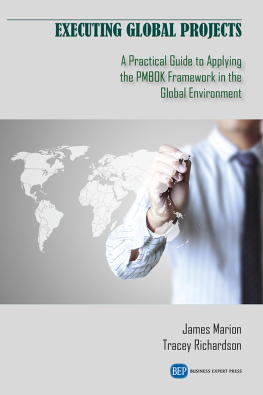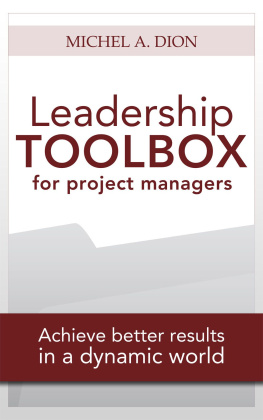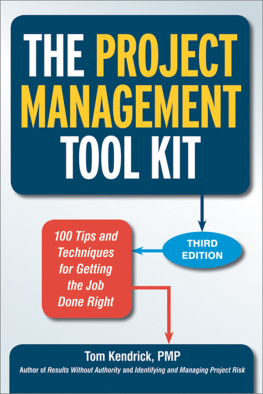What is so special about projects that are planned and executed within the global environment? Why should project managers concern themselves with examining global projects as something distinct from projects that are purely local, regional, or national in scope? This question may be answered in a single word complexity . Global projects include significantly more variables to manage including the macroenvironment. The global macroenvironment is vast and includes the political, economic, social, and technological factors in which a global project is executed. Further, project managers encounter language and cultural barriers that often involve fundamentally different approaches to management itself. To make an analogy, when project managers face such factors, it is rather like attempting to drive a car from one location to another while wearing a blindfold. The environment faced by the project manager may be quite alien, thereby leading to confusion, miscommunication, conflict, and stress. On the other hand, when project managers take the time to understand the global project management environment and become more comfortable with the added complexity, it is not uncommon to find global project management to be a successful and rewarding experience ().
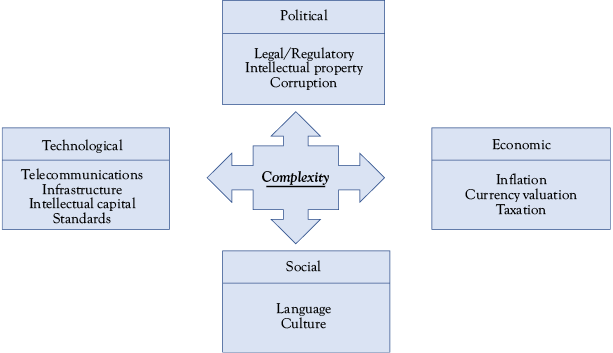
Figure 1.1 The global project management environments
Whether a project manager desires to lead a global project or not, projects today are increasingly global in scope. Often an apparently purely local project will include some components, subsystems, software, technology, or labor sourced from outside of the home country. As a result, even local project managers may be required to communicate with or travel to suppliers who are outside of the home country. These requirements present little problem since modern technology has made it possible to communicate in real time anywhere on the globe. Further, jet travel makes it possible to travel from any major city in the world to any other major city in less time than it was required to travel between the original Greek city states in antiquity. The world is effectively smallerbut since the world is round and it is not physically smaller, the apparent smallness enables global projects but leaves the additional stresses, strains, and complexities in place. Jumping into a global project without serious consideration of the many facets of the global macroenvironment is much like planning a project that includes a significant component of scope that is hidden and not revealed until later in the project. There is more at stake, more at risk, and more for the project manager to do in a global project than any project that is carried out on a purely local scale.
Complexity = Risk
The many additional factors that a global project manager must consider effectively increases the overall project risk. Like any project risk uncovered by the project team, the risks associated with the global environment may be identified, analyzed, ranked, and linked to appropriate risk responses. Given the special nature of the global macroenvironment, a separate and distinct global risk register may be created to track and keep an ongoing appraisal of global risks. Further, in large-scale projectswhich global projects often areit is recommended to have a project team member assigned to own and lead the project team in managing these risks ().
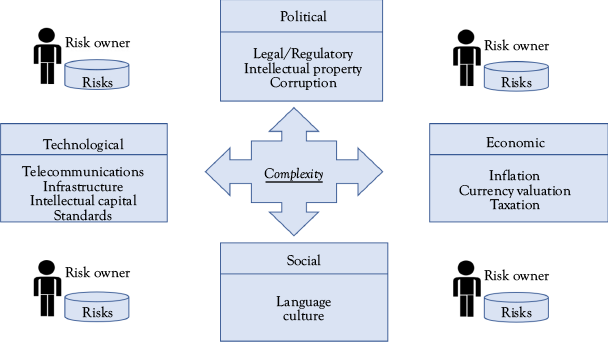
Figure 1.2 Global risk and risk owners
One reason for approaching global project risks in this manner is that the logistics of implementing risk responses is likely to be far more complex than that involved in purely localized risk responses. It is simpler to call a meeting with local suppliers to resolve an issue, but addressing problems with suppliers and contractors in Eastern Europe, India, and Asiaat the same timepresents unique difficulties. The scale of global risks that materialize into issues are likely to reach the scope of a major subproject. It is for this reason that in-depth global project risk identification, risk analysis, and risk response scenario planning is assigned to and carried out by the owner of the global project risk register.
Start with SWOT the PEST
The Guide to the Project Management Body of Knowledge (PMBOK) includes knowledge areas associated with each discipline required for carrying out each of the process groups. There is no single process group associated with managing a project within the global environmentbut perhaps there should be. At minimum, a project team could create, as is required in most knowledge areas, a plan for a plan, that is, a strategy for managing each of the knowledge area disciplines in the context of complexities unique to the global environment. Another way of saying this is to develop a strategy for planning and executing the global project. A good practice in strategic management suggests that the place to start in developing strategy is to begin by evaluating the big picture by assessing both the internal and external environment of the firm and sizing up the resulting strengths and weaknesses. The big picture evaluation is followed by identifying what appropriate actions should be taken to shore up weaknesses as well as enhance strengths. This could be thought of as identifying positions to defend as well as positions to achieve within the project considering the project capability today (as-is) as well as where the project needs to be in the future (to-be). The process of global strategy development within the project environment need not differ significantly from that of the firmthe primary exception being the temporary nature of the project as well as its focus on producing tangible deliverables.
The Big Picture
The big picture view of strategy begins with the analysis of the Strengths, Weaknesses, Opportunities, and Threats, or SWOT analysis of the project as it faces the global macroenvironment. A mnemonic device for SWOT analysis in global projects is the phrase SWOT the PEST, or the evaluation of Strengths, Weaknesses, Opportunities and Threats in light of the Political, Economic, Social and Technological environment in which the project is planned and executed. In the corporate environment, a SWOT analysis is focused on attaining and maintaining a competitive advantage. In the global project environment, SWOTting the PEST is all about understanding the capabilities, liabilities, opportunities, and vulnerabilities given the additional factors afforded by the global environment. One approach to doing this is to carry out a brainstorming session where each PMBOK knowledge area is analyzed using a SWOT analysis with a special focus on PEST. A generic example of the output of this process is provided in (Project Management Institute 2017).
Table 1.1 SWOT analysis of PMBOK knowledge areas
Knowledge Area | Strength | Weakness | Opportunity | Threat |
Integration | Process differences Decision making |
Scope | Change
management process | Hidden additional scope |
Schedule |
Cost | Travel, communication, currency valuation |
Quality |
Resources | Virtual team management | Software
development teams: India, Eastern Europe |
Communication | Language, Culture | Intranet
application, Skype
implementation | |
Next page
